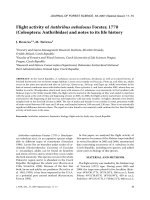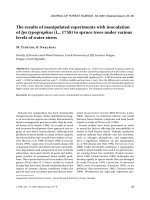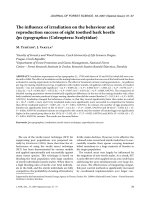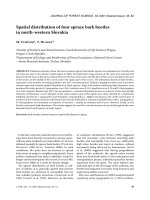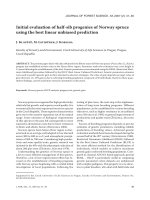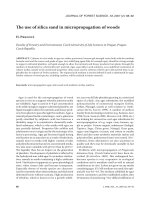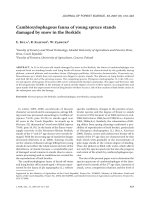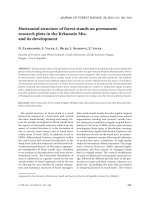Báo cáo lâm nghiệp: "Water relations of cork oak (Quercus suber L.) seedlings in response to shading and moderate drought" ppt
Bạn đang xem bản rút gọn của tài liệu. Xem và tải ngay bản đầy đủ của tài liệu tại đây (301.94 KB, 8 trang )
377
Ann. For. Sci. 62 (2005) 377–384
© INRA, EDP Sciences, 2005
DOI: 10.1051/forest:2005033
Original article
Water relations of cork oak (Quercus suber L.) seedlings in response
to shading and moderate drought
Marta PARDOS
a
*, M. Dolores JIMÉNEZ
a
, Ismael ARANDA
a
, Jaime PUÉRTOLAS
b
, José A. PARDOS
b
a
CIFOR-INIA, Ap. Correos 8.111, 28080 Madrid, Spain
b
U.D. Anatomía, Fisiología y Genética, ETSI Montes, UPM, 28040 Madrid, Spain
(Received 10 June 2004; accepted 29 September 2004)
Abstract – The interactive effects of light and drought on water relations and soluble sugars were addressed on Quercus suber L. seedlings
grown under the combination of four irradiances and two soil water contents. Leaf water potentials at predawn and midday were lower for water
stressed seedlings, independently of light environment. Osmotic potentials at full (Ψπ
100
) and zero turgor (Ψπ
0
) decreased with drought, under
the four light treatments. However, the decline was greater with the development of water stress under the two treatments of higher light
availability. The higher soluble sugar concentrations in seedlings grown under higher irradiances provoked a decrease of Ψπ
0.
The decrease in
Ψπ
100
and Ψπ
0
in moderate stressed seedlings was accompanied by an increase in ε
max
. The lower ability for osmotic adjustment in seedlings
grown under moderate water stress and low light environment suggested a lower efficiency in developing physiological mechanisms for drought
tolerance in shade-grown seedlings.
cork oak / drought / light / osmotic adjustment / soluble sugars
Résumé – Relations hydriques des semis de chêne-liège (Quercus suber L.) en réponse à l’ombre et à une sécheresse modérée. Les effets
interactifs de la lumière et de la sécheresse sur les relations hydriques et les sucres solubles ont été étudiés sur des plantules de Quercus suber
L. qui ont poussé sous la combinaison de quatre éclairements différents et de deux contenus en eau du sol. Les potentiels hydriques foliaires
mesurés l’un avant l’aube et l’autre à midi étaient plus bas pour les plantules subissant un stress hydrique indépendamment du niveau
d’éclairement. La pression osmotique à pleine turgescence (Ψπ
100
) et la pression osmotique à turgescence nulle (Ψπ
0
) ont diminué avec la
sécheresse sous les quatre éclairements. Cependant, les diminutions étaient plus grandes pour les plantules soumises à un stress hydrique et à
un éclairement élevé. La plus grande concentration de sucres solubles des plantules ayant poussé sous un plus grand éclairement a provoqué la
diminution de Ψπ
0
. La diminution de Ψπ
100
et de Ψπ
0
pour les plantules ayant poussé sous une sécheresse modérée a été accompagnée d’une
augmentation de ε
max
. La moindre capacité pour l’ajustement osmotique des plantules ayant poussé sous un stress hydrique modéré et une faible
intensité lumineuse a montré une plus faible efficacité pour le développement des mécanismes physiologiques de tolérance à la sécheresse de
ces plantules ayant poussé à l’ombre.
chêne-liège / sécheresse / lumière / ajustement osmotique / sucres solubles
1. INTRODUCTION
Light [10, 48, 52] and soil water moisture [32, 34] are among
the major factors constraining primary productivity of Medi-
terranean species and, thus, that may contribute significantly
to the future stand composition. Acclimation to different light
environments occurs at both whole-plant and leaf levels [24];
leaf acclimation being associated with morphological, anatom-
ical and physiological changes [31]. It is suggested that plants
genotipically adapted to open sunny habitats have the ability
to acclimate and grow under shaded conditions [42]. In partic-
ular, seedlings growing under high irradiances are able to main-
tain the turgor when water is limitant by decreasing the osmotic
potential, through the accumulation of osmotically active sol-
utes or by changing the bulk leaf modulus of elasticity [1, 5,
9]. However, Meletiou-Christou et al. [30] comparing sun and
shade leaves of four evergreen sclerophylls, did not find any
significant differences in the soluble sugar concentration.
Light levels in the understory of mature cork oak stands in
Spain, can vary from 12 to 70% of incident radiation, depending
on the structure of the stand [33]. Mortality of cork oak germi-
nants in open areas can reach up to 90 to 100% due to the joint
effect of rodents seed predation and summer drought [54]; but
once the first growing season is overcome, seedlings are able
to persist for 2 to 4 years and live in a suppressed state, through
the dieback of the shoot during the droughty summers, followed
by resprouting in the fall. The result is a recruitment of seed-
lings of variable age, not more than 30 cm high, with a deep
root system, that in most cases are not able to perform ade-
quately, as long as favourable conditions for growth do not
* Corresponding author:
Article published by EDP Sciences and available at or />378 M. Pardos et al.
occur [29, 54]. Thus, although mature cork oak is a shade-intol-
erant evergreen species, which shows a water-saver strategy
under water stress [14, 34, 45], some canopy protection during
the seedling state favours its establishment and early growth.
In Mediterranean-type climates, plants are typically sub-
jected to water stress during summer. The scarcity of rainfall
during this season is generally associated with large solar radi-
ation loads [52]. When soil water is gradually depleted, phys-
iological mechanisms of drought tolerance, including stomatal
control of water loss, osmotic adjustment [35] and development
of hydraulic systems resistant to cavitation [39, 47], bring into
play turgor maintenance and prevention of water loss [13, 25,
28, 49, 50]. Indeed, drought tolerance in Mediterranean areas
has a relevant impact on the physiological response of seed-
lings, even under shade conditions [53].
Because it is unlikely that tree growth is limited by deficien-
cies of only one resource in nature, comparative responses to
multiple resources and their interactions are particularly rele-
vant to understand adaptative strategies [8, 17, 26]. In particu-
lar, the interaction of light and water stresses may be a
compromise between contradictory patterns on seedlings’
physiological response. The question that arises is whether the
mechanisms of drought tolerance are modified by leaf accli-
mation to long-term irradiance conditions [31]. According to
the trade-off hypothesis mentioned by Holmgren [23] and Sack
and Grubb [44], drought has a stronger impact on individuals
grown in deep shade (< 5% of full-light) than on those grown
under high irradiances. Thus, lower ability for osmotic adjust-
ment in leaves grown under increasing shade conditions within
the canopy has been reported [6]. In addition, π
0
may decrease
because of active osmolyte accumulation when seedlings of
drought-tolerant species are submitted to water stress [13].
There are some studies concerned with water relations in
response to light and drought and their interactions, for medi-
terranean species [11, 21, 31, 53, 55], but little is known about
cork oak. The aim of this work was to investigate leaf water
relations of containerised cork oak seedlings under changing
light and water conditions. The specific objectives were: (1) to
determine if the occurrence of osmotic and elastic adjustment
under moderate stress was similar in seedlings grown under dif-
ferent light environments; (2) to determine if shade can
decrease seedlings’ acclimation to water stress.
2. MATERIALS AND METHODS
2.1. Plant material and experimental design
A factorial experiment of two factors (light and water) of four and
two levels, respectively, with treatments replicated in three blocks,
was designed to test for main effects and interactions on water relation
variables measured throughout two drying cycles. The four light levels
varied from high to low PFD; the two water levels were well watered
versus moderate stress. Twenty plants were grown under each com-
bination and five plants per treatment combination and date were used
for construction of P-V curves.
Acorns of cork oak (Quercus suber L.) were collected from trees
of the Valle del Tiétar Iberian provenance in the fall of 2000, and stored
in moist plastic bags at 4 °C until germination in mid-April 2001. One
germinated acorn was planted in each 3-L pot (truncated square pyr-
amid containers, 25 cm height, 169 cm
2
and 64 cm
2
, upper and lower
cross-sectional area, respectively), filled with a mixture of fine sand
and peat moss (1:3, v/v). Five grams per litre of a six months control-
led-release fertilizer (N:P:K, 20:10:20 + micronutrients) was added to
the growing media. Seedlings were grown in the greenhouse (30 °C
day/10 °C night temperature, under natural photoperiod, 750–
850 µmol·m
–2
·s
–1
of radiation intensity at midday) and kept well
watered twice a week. On 27 May 2001 seedlings were placed under
a transparent plastic shelter (15 m long × 6.8 m wide × 2.3 m high),
with the sides and ends opened to facilitate circulation of air. Seedlings
were randomly divided in four groups, according to the four light envi-
ronments. Plants were grown under metal frames with different layers
of neutral shade white cloth (Polysack Plastic Industries Ltd., Israel)
to produce the four light environments. The design of the frame was
optimized to avoid any effect on the temperature of the air in contact
with the plants. The average photosynthetic photon flux density (PFD)
under each light environment during a sunny day was: HL1: 66–70%
(34.66 mol·m
–2
·day
–1
); HL2: 44–50% (23.22 mol·m
–2
·day
–1
), LL1:
13.5–16% (7.92 mol·m
–2
.day
–1
) and LL2: 5–6% (2.59 mol·m
–2
.day
–1
)
of full sunlight.
Seedlings under each frame were randomly divided in two groups,
one of which was watered to field capacity twice per week (W+) and
the other group was subjected to a series of two soil-drying cycles of
51 and 38 days (W–), respectively, beginning on 23 July and extending
to 24 October. Moderate water-stressed seedlings (W–) were watered
to runoff at the end of the first drying cycle. Volumetric soil water con-
tent was monitored twice per week at 15 cm depth with time domain
reflectometry (TDR, Trase System I, Soil Moisture Equipment Corp.,
USA). Volumetric soil water content in the well-watered seedlings
(W+) was maintained between 25% and 35%, while seedlings under
moderate stress (W–) were allowed to dry to a water content between
7% and 10% (end of the first soil-drying cycle) (Fig. 1). The exact
amount of water supplied in the W– treatment was a function of the
volume of water lost under the lowest PFD (LL2), which had the min-
imum evaporative demands. By this means, a slow rate of imposition
Figure 1. Variation on volumetric soil moisture content throughout
the study on seedlings grown under different light environments
(HL1: square; HL2: triangle; LL1: circle; LL2: diamond) and watered
to field capacity (solid symbols) or submitted to two soil-drying
cycles (open symbols). Volumetric soil water content in the W+ see-
dlings was maintained between 25% and 35%, while W– seedlings
were allowed to dry to a water content between 7% and 10%. At the
end of the first soil-drying cycle W– seedlings were watered to runoff
on 20 and 23 Sept, before beginning the second soil-drying cycle.
Arrows showed date of P-V curves construction. Analysis of variance
in every measuring date showed no significant differences between
light levels for seedlings in W– or W+ treatment (P > 0.05).
Water relations of cork oak seedlings 379
of the water stress conditions was assured. Analysis of variance of
water content in every measuring date showed no significant differ-
ences between light levels for seedlings in the W– treatment (P > 0.05).
2.2. Measurements
At the end of each soil-drying cycle, five plants per each light ×
water regime combination were harvested for determination of tissue
water relation parameters. Previous to construction of pressure-vol-
ume (P-V) curves, predawn water potential (Ψ
pd
) was measured in one
leaf of the same seedlings, with a pressure chamber (PMS 1000, PMS
Instrument Co., Corvallis, OR, USA). In addition, predawn (Ψ
pd
) and
midday water potential (Ψ
min
) were measured between July and Octo-
ber (Ψ
pd
and Ψ
min
: July 23, Aug 13, Aug 27; Oct 3; Ψ
pd
: Sep 9, Oct 24)
to assess the water status of the seedlings. At each measurement date,
five seedlings were randomly selected from each light × water regime
combination.
For construction of P-V curves, three fully expanded leaves were
sealed with parafilm and the base of the petiole was placed in distilled
water in a beaker after recutting under water. Leaves were allowed to
rehydrate for an hour at room temperature. Special care was taken to
prevent oversaturation of apoplasmic and intercellular spaces in leaves
because of inmersion. Oversaturation during the first steps of dehy-
dration causes the shift in leaf saturation deficit due to water losses
without changes in measured water potential [16, 27]. The repeat pres-
surization technique [22] was used to construct PV curves from a series
of parallel fresh weight and pressure chamber Ψ measurements. After
each Ψ measurement, leave samples were removed from the chamber,
weighed again inmediately and allowed to air dry between consecutive
Ψ determinations. When approximately 7–8 data points on the appar-
ent linear portion of the PV curves were obtained, samples were placed
in an oven at 70 °C for 48 h to obtain leaf dry weight (DW). Sample
relative water content (RWC) was calculated as (fresh weight – dry
weight) / (turgent weight – dry weight). Weight at turgor was derived
from the relationship between fresh weight and water potential. Data
points above loss of turgor were identified and turgent weight deter-
mined by linear regression (r
2
> 0.98) [27].
For the derivation of PV parameters, paired observations of Ψ and
RWC were plotted using (1/Ψ) transformations [51] to identify data
points to be included in simple regression analysis of the linear portion
of PV curves. For the regression analysis, 1/Ψ and RWC were used as
the dependent and independent variables, respectively. The x- and y-
intercepts yielded estimates of the water content in the symplast at full
turgor (RWC
a
) and inverse of osmotic potential at full turgor (Ψπ
100
).
The x- and y-coordinates of the first data point of the linear portion
of the PV curve corresponded to relative water content at the turgor-
loss point (RWC
0
) and inverse of osmotic potential at the turgor-loss
point (Ψπ
0
). From the relationship between 1/Ψ and RWC, the rela-
tionship between turgor pressure (P) and RWC was calculated. Values
for the bulk tissue elastic modulus (ε) were calculated from this latter
relationship. The bulk tissue elastic modulus is defined as the change
in tissue turgor pressure for a given fractional change in symplastic
content (ε = dP/dRWC (RWC – RWC
a
)). Osmotic and elastic adjust-
ments, defined as the decrease in osmotic potential at full turgor or in
ε, respectively, in response to water deficits were calculated. Esti-
mates of Ψπ
100
and ε were used to characterize osmotic and elastic
adjustments.
After construction of P-V curves, five to six leaves per seedling
were oven-dried at 70 °C during 48 h and ground in a mill fitted with
a 0.7 mm screen. Samples were analysed for soluble sugar concentra-
tion (mmol). Approximately 0.1 g of ground tissue was extracted three
times in boiling 80% (v/v) ethanol, centrifuged and the supernatants
pooled. Soluble sugars were quantified spectrophotometrically fol-
lowing reaction with anthrone [46].
2.3. Statistical analysis
A factorial arrangement of sample date, water regime and light was
employed in a completely randomized design. Analysis of variance
was conducted using the SAS GLM procedure. Comparison of mean
treatment differences was done by Tukey test. As sample date was not
significant, data from the two harvests were pooled, and a two-way
fixed effects general linear model with the treatments of water regime
and light as the main effects was used. The relationship between var-
iables was assessed using the Pearson (r) coefficient, and considering
the individual values of all seedlings.
Linear regressions of osmotic potential at full turgor (Ψπ
100
, MPa)
and at the turgor-loss point (Ψπ
0
, MPa) with predawn water potential
(Ψ
pd
) were made. In a first step, functions were fitted to data from each
light treatment independently (1). In a second step, a unique fit was
made for all the data (2). In a third step, data from the four light treat-
ments were grouped in two groups, high light (HL = HL1 + HL2) and
low light (LL = LL1 + LL2), and two new functions were fitted to
them (3). Once all regressions were proved significant, we determined
whether significant differences exist among light treatments by a
F-test for detecting simultaneous homogeneity among parameters of
the regressions. The method requires the fitting of a full and a reduced
model. The full model fitted a function for each light treatment. When
comparing (1) and (2), the reduced model made a unique fit to all four
treatments in the data set. When comparing (1) and (3), the reduced
model fitting was done by calculating a different set of parameters for
HL and LL groups
The F-test uses the following statistic:
where SS
f
= sum of squares error for full model; SS
r
= sum of squares
error for reduced model; df
f
= degrees of freedom for full model; df
r
=
degrees of freedom for reduced model. The statistical decision rule at
the given significance α level is:
If F > F
Fisher-Snedecor
(1-α; dfr-df
f
; df
f
), the separate models are
required.
If F < F
Fisher-Snedecor
(1-α; dfr-df
f
; df
f
), the reduced model is appro-
priate.
3. RESULTS
Significant differences between water regimes were found
for Ψ
pd
and Ψ
min
in all measurement dates (P < 0.001), except
at the beginning of the two soil-drying cycles (July 23 and
Oct 3), when soil water moisture was high and similar in all
seedlings (Fig. 2). Well-watered seedlings had higher values of
Ψ
pd
and Ψ
min
compared to seedlings submitted to moderate
water stress (Fig. 2). The lowest Ψ
pd
values in the moderate
water stressed seedlings were shown at the end of each soil-
drying cycle. Predawn water potential (Ψ
pd
) and midday water
potential (Ψ
min
) were not affected by light (P > 0.05); this result
elucidated a similar imposition of the water regime, independ-
ently of the irradiance under which seedlings were grown
(Fig. 2).
Soluble sugar concentration expressed on a leaf area basis
was significantly higher under high light environments (HL1
and HL2), for both water regimes (P < 0.001, Fig. 3). The con-
centration under the HL1 treatment was between 1.8 (for W+)
and 2.8-fold (for W–) the value under the LL2 treatment.
f
f
fr
fr
df
SS
dfdf
SSSS
F
−
−
=
380 M. Pardos et al.
Both the osmotic potential at full turgor (Ψπ
100
) and at the
turgor-loss point (Ψπ
0
) were significantly affected by water and
light treatments, although their variation was mostly explained
by water availability (Tab. I). Thus, moderate water-stressed
seedlings showed significant lower Ψπ
100
and Ψπ
0
under the
four light treatments (Fig. 4). Seedlings grown under LL1 and
LL2 light levels showed higher Ψπ
100
and Ψπ
0
, than seedlings
grown under HL1 and HL2. Bulk modulus of elasticity at max-
imum turgor (ε
max
) was affected by water regime, but only
under the two highest light environments (HL1 and HL2) (Fig.
4). High cell-wall rigidity was related to high RWC
0
and low
RWC
a
, Ψ
pd
, Ψπ
100
and Ψπ
0
(Tab. II). The rest of parameters
derived from the P-V curves (relative water content at the turgor
loss point, RWC
0
, and relative symplastic water content,
RWC
S
) showed no evident trend related to treatment. Estimates
of Ψπ
100
are used to characterize osmotic adjustment, and
decreases of 0.48, 0.46, 0.28 and 0.28 MPa were recorded for
the HL1, HL2, LL1 and LL2, respectively.
At a significant level α = 5%, when comparing (1) and (2),
we reject the null hypothesis of parameters homogeneity,
which means that separate models were required for each of the
four light treatments. When comparing (1) and (3), we cannot
reject the null hypothesis, accepting that the reduced model was
appropriate for the light treatment. Thus, a different model was
fitted for the high light group (HL = HL1 + HL2) and the low light
group (LL = LL1 + LL2). Values of F statistic and results of fitting
the functions for the HL and LL groups are shown in Table III.
For both light groups, Ψπ
100
and Ψπ
0 values
in seedlings sub-
mitted to a moderate water stress were significantly lower than
values in the well irrigated seedlings (Fig. 5). Low Ψ
pd
induced
low Ψπ
100
and Ψπ
0
values, irrespective of light environment.
4. DISCUSSION
Tissue water relation parameters in cork oak seedlings
changed in response to water availability and light environ-
ment. Water potential (Ψ
pd
and Ψ
min
) was higher in well-irri-
gated seedlings, for all light levels, suggesting a generally small
effect of light on water potential, as previously reported by
Rhizopoulou et al. [42] in four Mediterranean evergreen scle-
rophylls. At the end of the second soil-drying cycle, there was
a significant trend for higher Ψ
pd
values in well-irrigated seed-
lings grown under the high light environments (–0.45 MPa in
HL1 and HL2 vs. –0.49 MPa in LL1 and LL2, P = 0.0129,
Fig. 2). Similarly, Abrams [1] and Kloeppel et al. [25] found
higher Ψ
pd
under sunny conditions, although it is not a general
pattern [5, 17, 41, 53].
The decrease in osmotic potential (Ψπ
100
and Ψπ
0
) as water
availability decreased and PFD increased, allows seedlings to
maintain a water potential gradient from the soil to the plant
and to facilitate water uptake. Although no interaction was
Figure 2. Time course of (a) predawn (Ψ
pd
, MPa) and (b) midday leaf water potential (Ψ
min
, MPa) on cork oak seedlings watered to field
capacity (W+) or submitted to a moderate water stress (W–) and grown under different light environments [HL1 (66–70%): ; HL2 (44–50%):
; LL1 (13.5–16%): ; LL2 (5–6%): ].
(a) (b)
Water relations of cork oak seedlings 381
shown between light and water availability, Ψπ
0
was lower
under high light (HL1 and HL2) for both water regimes. In addi-
tion, Ψπ
100
was lower under high light (HL1 and HL2), but only
for moderate water-stressed seedlings. As suggested by Aranda
et al. [7] the additive effect of high irradiance and low water
availability can start mechanisms of drought tolerance such as
a decrease on Ψπ
0
. Active accumulation of solutes decreases
Ψπ
0
, acting to sustain a gradient in Ψ between plant protoplasm
and the soil solution [8]. In this way, osmotic adjustment may
facilitate water uptake, turgor potential maintenance, and tissue
survival at the low tissue Ψ that results from water stress. For
both water treatments, seedlings grown at high irradiances
Tabl e I . Analysis of variance for pressure-volume curve parameters.
Factors are light (d.f. 3), water (d.f. 1), and their interaction (d.f. 3).
Variable Factor FP
Ψπ
0
Light
Water
Light × Water
9.34
43.09
0.16
< 0.0001
< 0.0001
0.9246
Ψπ
100
Light
Water
Light × Water
6.32
35.83
0.67
0.0008
< 0.0001
0.5750
Ψ
pd
Light
Water
Light × Water
0.48
45.00
0.54
0.6964
< 0.0001
0.6534
Ψ
pd
– Ψπ
0
Light
Water
Light × Water
6.26
3.72
0.23
0.0008
0.0196
0.8773
RWC
0
Light
Water
Light × Water
0.30
0.25
0.79
0.8234
0.6177
0.5039
RWCa Light
Water
Light × Water
1.36
0.03
0.10
0.2621
0.8739
0.9624
ε
max
Light
Water
Light × Water
0.74
3.70
2.25
0.5307
0.0500
0.0909
Figure 3. Sugar soluble concentration (mg glucose·cm
–2
) in leaves
of cork oak seedlings grown under four light environments (HL1: 66–
70%; HL2: 44–50% , LL1: 13.5–16% and LL2: 5–6% of full sunlight)
and watered to field capacity (W+) (a), or subjected to a moderate
water stress (W–) (b). Means separation between light environments
by t-test, P < 0.05.
Figure 4. Osmotic potential at full (Ψπ
100
, MPa) (a) and at turgor-
loss point (Ψπ
0
, MPa) (b), and bulk modulus of elasticity (ε
max
, MPa)
(c) in cork oak seedlings watered to field capacity, W+ (white sym-
bols) or submitted to two soil-drying cycles, W– (black symbols),
under different light environments (HL1: 66–70%, HL2: 44–50%,
LL1: 13.5–16% and LL2: 5–6% of full sunlight).
382 M. Pardos et al.
showed a higher soluble sugar concentration than seedlings
grown under low irradiances. Similar results have been
reported by Niinemets [36] in three temperate woody species
and by Johnson et al. [24] in Fagus sylvatica, but contrast to
those presented by Meletiou-Christou et al. [30] in four Medi-
terranean evergreen sclerophylls, which showed no substantial
differences on soluble sugars when comparing sun and shade
leaves. Changes on water availability through the growing sea-
son did not affect either soluble sugar concentration in two-
year-old cork oak seedlings grown outdoors in Portugal,
although mean values are higher than ours (between 1.0 and
1.7 mg glucose·cm
–2
), probably related to seedling age [12].
The higher soluble sugar concentrations in seedlings grown
under higher irradiances provoked a decrease of the osmotic
potential at full turgor (Ψπ
100
) and are at least partly responsible
for osmotic adjustment [31].
As the response to light environment was the same under
both water levels, with the highest values under the high light
levels (HL1 and HL2) and the lowest under the low light levels
(LL1 and LL2), seedlings could be arranged in two groups
according to their response to the light environment: low light
level (LL = LL1 + LL2 < 16% of full sun light) and high light
level (HL = HL1 + HL2 > 40% of full sun light). Similar groups
were defined when regressions between Ψπ
100
vs. Ψ
pd
and Ψπ
0
vs. Ψ
pd
were made (Fig. 5). Leaves grown under high light typ-
ically developed lower osmotic potential relative to shaded
leaves [4, 8]. The lower Ψπ
100
and Ψπ
0
irrespective of
Ψ
pd
as
irradiance increased has been related to lower daily leaf water
potential, due to a more droughty environment [37]. Although
the relationship between Ψπ
100
vs. Ψ
pd
with high coefficients
Table I I. Correlation values (Pearson’s r) of different water relation parameters considering all seedlings (n = 80). Probability values are
shown in parenthesis (values in bold: P < 0.05), ns: non-significant. Abbreviations: predawn leaf water potential (Ψ
pd
, MPa), leaf water poten-
tial al the turgor-loss point (Ψπ
0
, MPa), osmotic potential at full turgor (Ψπ
100
, MPa), relative water content at turgor-loss point (RWC
0
), rela-
tive apoplastic water content (RWC
a
), turgent to dry weight ratio (TW/DW), bulk modulus of elasticity at maximum turgor (ε
max
, MPa).
Ψ
pd
Ψπ
0
Ψπ
100
RWC
0
RWC
a
Ψπ
0
Ψπ
100
RWC
0
RWC
a
ε
max
0.52 (< 0.0001)
0.51 (< 0.0001)
ns
ns
–0.37 (0.0011)
0.92 (< 0.0001)
0.29 (0.0114)
0.22 (0.0570)
–0.30 (0.0090)
ns
0.40 (0.0003)
–0.56 (< 0.0001)
0.59 (< 0.0001)
0.27 (0.0195)–0.39 (0.0007)
Table III. Linear regression analysis, using the equations Ψπ
0
= a +
b.Ψ
pd
or Ψπ
100
= a’ + b’.Ψ
pd
. F statistic and summary results for the
fit of the functions are shown. (1) functions are fitted to data from
each light treatment independently; (2) a unique fit is made for all
the data; (3) data from the four light treatments are grouped in high
light (HL = HL1 + HL2) and low light (LL = LL1 + LL2) environ-
ments, and two new functions are fitted to them.
Light groups n Ψπ
0
vs. Ψ
pd
Ψπ
100
vs. Ψ
pd
FP > FFP > F
(1) vs. (2) 75 5.823 6.300E–5 4.063 0.0016
(1) vs. (3) 75 0.500 0.736 0.613 0.655
Ψπ
0
vs. Ψ
pd
Ψπ
100
vs. Ψ
pd
Parameter estimates r
2
Parameter estimates r
2
ab a’b’
HL 1.09 –2.07 0.40 0.94 –1.48 0.37
LL 1.33 –1.48 0.35 0.92 –1.19 0.28
Figure 5. (a) Osmotic potential at turgor-loss point (Ψπ
0
) and (b) at
full turgor (Ψπ
100
) plotted against predawn water potential (Ψ
pd
).
Data are derived from seedlings watered to field capacity, W+ (solid
symbols) or subjected to a moderate water stress, W–(open symbols),
and grown under high light, HL (triangles) or low light conditions,
LL (circles). Also shown are fitted curves for pooled data of seedlings
grown under high light (––––) or low light conditions ( ).
(a)
(b)
Water relations of cork oak seedlings 383
of determination (r
2
> 0.7) has been reported [3, 19], the lower
coefficients in our study (r
2
> 0.28) can result from the mod-
erate water stress applied.
In oak species, drought commonly results in decreases in
Ψπ
100
of about 0.6 MPa or less [2, 3, 6, 13, 14]. Decreases in
osmotic potential near to 0.5 MPa under moderate drought con-
ditions and differences in osmotic adjustment between seed-
lings grown under low light (LL1 and LL2) and high light (HL1
and HL2) environments of 40% demonstrated an osmotic
adjustment capacity in accordance to water conditions in our
study. In any case, and under both light environments, cork oak
readily displayed osmotic adjustment with little change in Ψ
pd
,
similarly to results reported in chestnut oak in an upland oak
forest during a dry year [49]. Moreover, our results suggested
a more limited osmotic adjustment under low light conditions
(0.28 MPa) than under high light conditions (0.47 MPa), as
reported by Augé et al. [8] with Rosa seedlings. Osmotic adjust-
ment in seedlings grown under the high light environment
(HL1) was also accompanied by an elastic adjustment of
3.6 MPa. The increase in osmotic adjustment capacity with
light went in parallel with an increase in photosynthetic capac-
ity (data not shown). Previous studies demonstrated the higher
ability to osmotic adjustment in plants growing under high light
environments [15, 31, 40]. The values of osmotic adjustment
for seedlings grown under low light conditions are similar to
those obtained in xeric North American oak species [3]. Values
of osmotic adjustment under high light conditions are similar
to those reported by Collet and Guehl [13] on sessile oak after
subjecting seedlings to a slow rate of water deficit increase.
The decrease in osmotic potential at turgor loss point and at
full turgor in moderate stressed seedlings was accompanied by
an increase in ε
max
. This is a characteristic of plants adapted
to tolerate water stress [20, 43]. This increase in ε
max
will result
in a more rapid loss of turgor for a given loss in tissue water
content and hence may appear to be a disadvantage during
drought [17]. However, an increase in tissue rigidity may con-
fer physiological and ecological advantages [8]. A lower cell
wall elasticity would allow leaf water potential to drop rapidly
and substantially as soon as the leaves began to loose water [34,
38] and a rapid recovery after a decrease in soil water content,
which is shown as an efficient mechanism to overcome water
stress [14]. It has been suggested that a higher ε
max
value
increases water absorption in a drying soil by increasing the
soil-plant water potential gradient [18]; although both lower
and higher elasticity have been suggested as promoting turgor
maintenance.
Results of this study suggest the development of different
physiological mechanisms to withstand environmental condi-
tions in sun and shade-grown seedlings. Osmotic and elastic
adjustments are found to help cork oak seedlings to maintain
turgor during moderate water stress and under high light envi-
ronment (> 40% of full sun). In contrast, in seedlings grown
under moderate water stress and low light environment (< 16%
of full sun), their main strategy in coping with stress was
osmotic adjustment; but its lower ability for such adjustment
suggests a lower efficiency in developing physiological mech-
anisms for drought tolerance, under low light conditions.
REFERENCES
[1] Abrams M.D., Physiological plasticity in water relations and leaf
structure of understory versus open-grown Cercis canadiensis L. in
northeast Kansas, Can. J. For. Res. 16 (1986) 1170–1174.
[2] Abrams M.D., Comparative water relations of three successional
hardwood species in central Wisconsin, Tree Physiol. 4 (1988)
263–273.
[3] Abrams M.D., Adaptations and responses to drought in Quercus
species of North America, Tree Physiol. 7 (1990) 227–238.
[4] Abrams M.D., Kloeppel B.D., Kubiske M.E., Ecophysiological and
morphological responses to shade and drought in two contrasting
ecotypes of Prunus serotina, Tree Physiol. 10 (1992) 343–355.
[5] Aranda I., Gil L., Pardos J.A., Effects of thinning in a Pinus sylves-
tris L. stand on foliar water relations of Fagus sylvatica L. seedlings
planted within the pinewood, Trees 15 (2001) 358–364.
[6] Aranda I., Gil L., Pardos J.A., Osmotic adjustment in two temperate
oak species [Quercus pyrenaica Willd and Quercus petraea (Matt.)
Liebl] of the Iberian Peninsula in response to drought, Investiga-
ción Agraria: Sistemas y Recursos Forestales 13 (2004) 339–345.
[7] Aranda I., Castro L., Pardos M., Gil L., Pardos J.A., Effects of the
interaction between drought and shading on water relations, gas
exchange and morphological traits in cork oak (Quercus suber L.)
seedlings, For. Ecol. Manage. 210 (2005) 117–129.
[8] Augé R.M., Stodola A.J.W., Pennell B.D., Osmotic and turgor
adjustment in Rosa foliage drought-stressed under varying irra-
diance, J. Amer. Soc. Hort. Sci. 115 (1990) 661–667.
[9] Blake T.J., Bevilacqua E., Zwiazek J.J., Effects of repeated stress
on turgor pressure and cell elasticity changes in black spruce see-
dlings, Can. J. For. Res. 21 (1991) 1329–1333.
[10] Castell C., Terradas J., Tenhunen J.D., Water relations, gas
exchange, and growth of resprouts and mature plant shoots of Arbu-
tus unedo L. and Quercus ilex L, Oecologia 98 (1994) 201–211.
[11] Cavender-Bares J., Bazzaz F.A., Changes in drought response stra-
tegies with ontogeny in Quercus rubra: implications for scaling
from seedling to mature trees, Oecologia 124 (2000) 8–18.
[12] Cerasoli S., Scartazza A., Brugnoli E., Chaves M.M., Pereira J.S.,
Effects of partial defoliation on carbon and nitrogen partitioning
and photosynthetic carbon uptake by two-year-old cork oak (Quer-
cus suber) saplings, Tree Physiol. 24 (2004) 83–90.
[13] Collet C., Guehl J.M., Osmotic adjustment in sessile oak seedlings
in response to drought, Ann. Sci. For. 54 (1997) 389–394.
[14] Corcuera L., Camarero J.J., Gil-Pelegrín E., Functional groups in
Quercus species derived from the analysis of pressure-volume cur-
ves, Trees 16 (2002) 465–472.
[15] Delpérée C., Kinet J.M., Lutts S., Low irradiance modifies the
effect of water stress on survival and growth-related parameters
during the early developmental stages of buckwheat (Fagopyrum
esculetum), Physiol. Plant. 119 (2003) 211–220.
[16] Dreyer E., Bousquet F., Ducrey M., Use of pressure volume curves
in water relation analysis on woody shoots: influence of rehydra-
tion and comparison of four European oak species, Ann. Sci. For.
47 (1990) 285–297.
[17] Ellsworth D.S., Reich P.B., Water relations and gas exchange of
Acer saccharum seedlings in contrasting natural light and water
regimes, Tree Physiol. 10 (1992) 1–20.
[18] Fan S., Blake T.J., Blumwald E., The relative contribution of elastic
and osmotic adjustments to turgor maintenance of woody species,
Physiol. Plant. 90 (1994) 408–413.
384 M. Pardos et al.
[19] Gebre G.M., Tschaplinski T.J., Shirshac T.L., Water relations of
several hardwood species in response to throughfall manipulation
in an upland oak forest during a wet year, Tree Physiol. 18 (1998)
299–305.
[20] Groom P.K., Lamont B.B., Xerophytic implications of increased
sclerophylly: interactions with water and light in Hakea psilorrhyn-
cha seedlings, New Phytol. 136 (1997) 231–237.
[21] Van Hees A.F.M., Growth and morphology of pedunculate oak
(Quercus robur L.) and beech (Fagus sylvatica L.) seedlings in
relation to shading and drought, Ann. Sci. For. 54 (1997) 9–18.
[22] Hinckley T.M., Duhme F., Hinckley A.R., Richter H., Water rela-
tions of drought hardy shrubs: osmotic potential and stomatal reac-
tivity, Plant Cell Environ. 3 (1980) 131–140.
[23] Holmgren M., Combined effects of shade and drought on tulip
poplar seedlings: trade-off in tolerance or facilitation? Oikos 90
(2000) 67–78.
[24] Johnson J.D., Tognetti R., Michelozzi M., Pinzauto S., Minota G.,
Borghetti M., Ecophysiological responses of Fagus sylvatica see-
dlings to changing light conditions. II. The interaction of light envi-
ronment and soil fertility on seedling physiology, Physiol. Plant.
101 (1997) 124–134.
[25] Kloeppel B.D., Kubiske M.E., Abrams M.D., Seasonal tissue water
relations of four successional pennsylvania barrens species in open
and understory environments, Int. J. Plant Sci. 155 (1994) 73–79.
[26] Kolb T.E., Steiner K.C., McCormick L.H., Bowersox T.W.,
Growth responses of northern red-oak and yellow-poplar seedlings
to light, soil moisture and nutrients in relation to ecological stra-
tegy, For. Ecol. Manage. 38 (1990) 65–78.
[27] Kubiske M.E., Abrams M.D., Pressure-volume relationships in
non-rehydrated tissue at various water deficits, Plant, Cell Environ.
13 (1990) 995–1000.
[28] Kwon K.W., Pallardy S.G., Temporal changes in tissue water rela-
tions of seedlings of Quercus acutissima, Q. alba, and Q. stellata
subjected to chronic water stress, Can. J. For. Res. 19 (1989) 622–
626.
[29] Larsen D.R., Johnson P.S., Linking the ecology of natural oak rege-
neration to silviculture, For. Ecol. Manage. 106 (1998) 1–7.
[30] Meletiou-Christou M.S., Rhizopoulou S., Diamantoglou S., Seaso-
nal changes of carbohydrates, lipids and nitrogen in sun and shade
leaves from four Mediterranean evergreen sclerophylls, Environ.
Exp. Bot. 34 (1994) 129–140.
[31] Mendes M.M., Gazarini L.C., Rodrigues M.L., Acclimation of
Myrtus communis to contrasting Mediterranean light environments-
effects on structure and chemical composition of foliage and plant
water relations, Environ. Exp. Bot. 45 (2001) 165–178.
[32] Méthy M., Damesin C., Rambal S., Drought and photosystem II
activity in two Mediterranean oaks, Ann. Sci. For. 53 (1996) 255–
262.
[33] Montero G., Cañellas I., Selvicultura de los alcornocales en España,
Silva Lusitana 11 (2003) 1–19.
[34] Nardini A., Lo Gullo M.A., Salleo S., Competitive strategies for
water availability in two Mediterranean Quercus species, Plant,
Cell Environ. 22 (1999) 109–116.
[35] Nguyen-Queyrens A., Costa P., Loustau D., Plomion C., Osmotic
adjustment in Pinus pinaster cuttings in response to a soil drying
cycle, Ann. For. Sci. 59 (2002) 795–799.
[36] Niinemets Ü., Role of foliar nitrogen in light harvesting and shade-
tolerance of four temperate deciduous woody species, Funct. Ecol.
11 (1997) 518–531.
[37] Niinemets Ü., Components of leaf dry mass per area- thickness and
density- alter leaf photosynthetic capacity in reverse directions in
woody plants, New Phytol. 144 (1999) 35–47.
[38] Osonubi O., Davis W.J., Root growth and water relations of oak
and birch seedlings. Oecologia 51 (1981) 343–350.
[39] Perks M.P., Irvine J., Grace J., Xylem acoustic signals from mature
Pinus sylvestris during an extended drought, Ann. For. Sci. 61
(2004) 1–8.
[40] Pothier D., Margolis H.A., Changes in the water relations of balsam
fir and white birch saplings after thinning, Tree Physiol. 6 (1990)
371–380.
[41] Reich P.B., Hinckley T.M., Water relations, soil fertility, and plant
nutrient content of a pygmy oak ecosystem, Ecology 61 (1980)
400–416.
[42] Rhizopoulou S., Meletiou-Christou M.S., Diamantoglou S., Water
relations for sun and shade leaves of four Mediterranean evergreen
sclerophylls, J. Exp. Bot. 42 (1991) 627–635.
[43] Robichaux R.H., Variation in the tissue water relations of two sym-
patric Hawaiian Dubautia species and their natural hybrid, Oecolo-
gia 65 (1984) 75–81.
[44] Sack L., Grubb P.J., The combined impacts of deep shape and drou-
ght on the growth and biomass allocation of shade-tolerant woody
seedlings, Oecologia 131 (2002) 175–185.
[45] Salleo S., LoGullo M.A., Sclerophylly and plant water relations in
three mediterranean Quercus species, Ann. Bot. 65 (1990) 259–
270.
[46] Spiro R.G., Analysis of sugars found in glycoproteins, in: Neufeld
E.F., Ginsburg V. (Eds.), Methods in Enzymology VIII, Complex
Carbohydrates, Academic Press, New York, 1966, pp. 3–26.
[47] Tissier J., Lambs L., Peltier J.P., Marigo G., Relationships between
hydraulic traits and habitat preference for six Acer species occur-
ring in the French Alps, Ann. For. Sci. 61 (2004) 81–86.
[48] Tognetti R., Michelozzi M., Borghetti M., Response to light of
shade-grown beech seedlings subjected to different watering regi-
mes, Tree Physiol. 14 (1994) 751–758.
[49] Tschaplinski T.J., Gebre G.M., Shirshac T.L., Osmotic potential of
several hardwood species as affected by manipulation of through-
fall precipitation in an upland oak forest during a dry year, Tree
Physiol. 18 (1998) 291–298.
[50] Thomas F.M., Gausling T., Morphological and physiological res-
ponses of oak seedlings (Quercus petraea and Q. robur) to mode-
rate drought, Ann. Sci. For. 57 (2000) 325–333.
[51] Tyree M.T., Ritchter H. Alternative methods of analysing water
potential isotherms: some cautions and clarifications. I. The impact
of non-ideality and some experimental errors, J. Exp. Bot. 32
(1981) 643–653.
[52] Valladares F., Pearcy R.W., Interactions between water stress, sun-
shade acclimation, heat tolerance and photoinhibition in the sclero-
phyll Heteromeles arbutifolia, Plant, Cell Environ. 20 (1997) 25–36.
[53] Valladares F., Pearcy R., Drought can be more critical in the shade
than in the sun: a field study of carbon gain and photo-inhibition in
a Californian shrub during a dry El Niño year, Plant Cell Environ.
25 (2002) 749–759
[54] Vieira Natividade J., Subericultura., Direc ao Geral dos Sevi os
Florestais e Aquicolas, Portugal, 1951.
[55] Welander N.T., Ottosson B., The influence of low light, drought
and fertilization on transpiration and growth in young seedlings of
Quercus robur L., For. Ecol. Manage. 127 (2000) 139–151.
ςς
